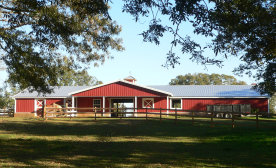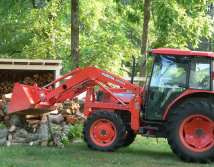
Farming/Ranching

A century ago, plentiful foundation stones were cut from the granite outcrops along the creeks, and bricks were made and stored not far from where Native Americans baked their pottery.
At the end of the 19th century, Mills’ Mill on Little River in the heart of present Foxbrier ground grist for neighboring farmers. Another owner ran a sawmill, tapping Foxbrier’s Shortleaf Pine forests.
Now, in a typical year, we will grow, cut, and bale 250,000 pounds of coastal bermuda and fescue/mixed grass hay. All our hay is stored in two weatherproof barns. Most of the hay goes to feed the cattle in winter while the rest is sold to local markets.
Points of Interest
At Foxbrier, as elsewhere in the agricultural industry, life is not a 9 to 5 job. The hours invested are not commensurate with the income, yet the joy of being outdoors and seeing things grow offsets the meager profits.
Across the centuries, the owners of the land have tried diverse schemes to make a living—from the original hunters and trappers, to cattle-raising in the “brakes” along the creeks, to large-scale cotton farming with slave and later share-cropping labor, to hewing stone and making bricks, to running a grist mill, to row-cropping corn, peas, soybeans and wheat, to the current enterprise: cattle and hay.
Today Foxbrier has settled into a more pastoral mood. In almost 500 acres of pastureland, Black Angus, Simmental/Angus cross, and Belted Galloway cattle graze. Most years we range 100 to 125 head, selling to local stockyards and other breeders. Horses of varied breeds provide riding and driving enjoyment as well as delight for the eye.



